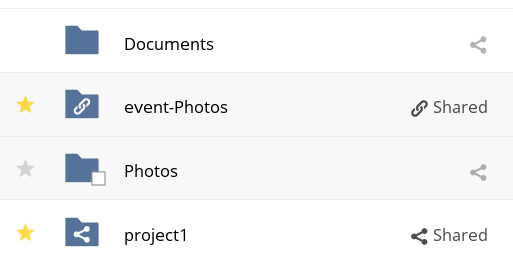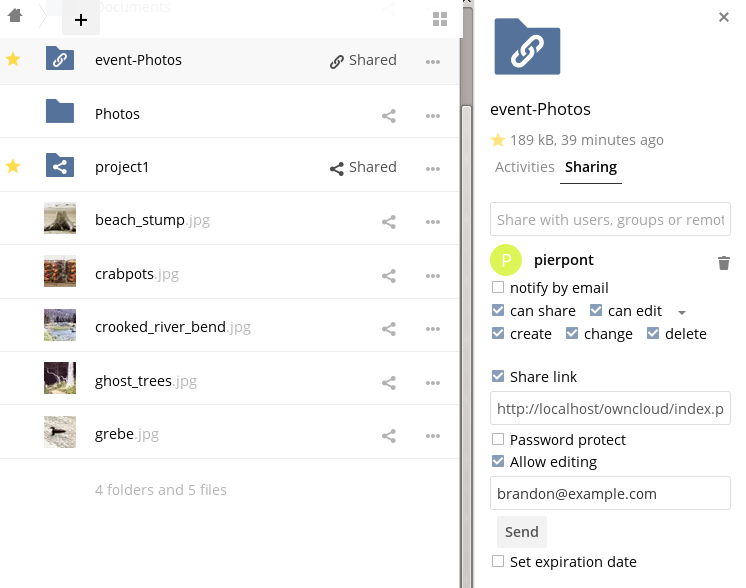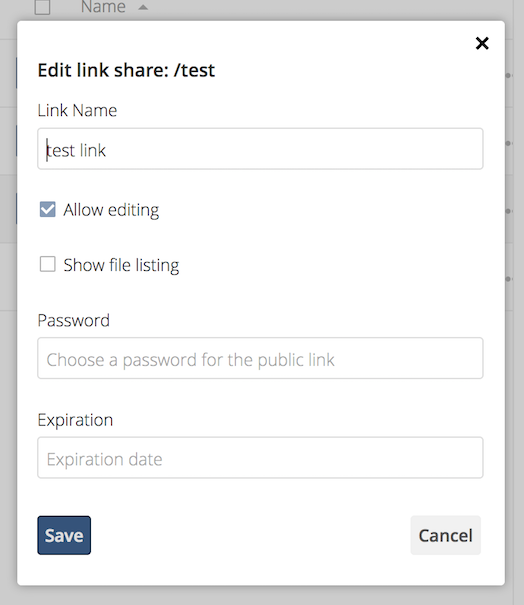Sharing Files
Clicking the share icon on any file or folder opens the Details view on the right, where the Share tab has focus.
Sharing Status Icons
Any folder that has been shared is marked with the Shared overlay icon. Public link shares are marked with a chain link. Un-shared folders are blank.

Creating Shares
To share a file or folder, immediately below the Share tab, you will see a text field. In this field, you can enter any number of users (whether local to your Cloud-Sync server or remote) or groups who you would like to share the file or folder with.
As username auto-completion is enabled, when you start typing the user or group name, the interface will automatically complete it for you, if possible.
After a file or folder has been shared, Share Permissions can be set on it. In the image below, you can see that the directory “event-Photos” is shared with the user “pierpont”, who can share, edit, create, change, and delete the directory.

What Happens When Share Recipients Move Files and Folders?
If a share recipient has “can edit” privileges and moves files or folders out of the share, the application stores a backup copy of the moved file/folder in the Deleted Files (Trash) of the share’s owner. The user who moved the file/folder out of the share still has the original copy there, along with its attached metadata.
That way, the files/folders are not permanently lost. By clicking the Restore link, next to the respective file or folder, it will restore these files/folders to their original location.

Restoring files restores the backup copy for all users, including the user that originally moved them, into the original folder.
Updating Shares
To change any of the properties of a share, again, you first need to view the Share tab. From there, you can:
- Delete a user’s access to a share
- Give more users access to a share
- Change a user’s share permissions
- Add or remove password protection
- Set or remove a share’s expiration date
Deleting Shares
Despite the name of this section, you don’t actually delete a share. Rather what you do is remove the access of user’s to whom it’s already been shared with. When all users access to a shared resource has been removed, the resource is no longer shared.
To do that, you need to click on the rubbish bin icon, on the far right-hand side of the name of each user it’s been shared with, who should no longer have access to it.
Password Protecting Files
It’s also possible to password protect shared files and folders. If you want to do so, then you need to enable this functionality. Specifically, click the checkbox labeled “Password protect” under the “Share Link” section.
When you do so, you’ll see a password field appear. In there, add the password that the user will need to enter to access the shared resource and press the return key.
Using Private Links
Another way to access a file or folder is via a private link. It’s a handy way of creating a permanent link for yourself or to point others to a file or folder, within a share, more efficiently. To access the private link, in the Sharing Panel for a file or folder, next to its name you’ll see a small link icon (1), as in the screenshot below.

If you click it, a new textbox will appear above the “Collaborative tags” field, populated with the link’s URI (2).
Only people who have access to the file or folder can use the link.
Changing The Share Expiration Date
-
You can only set an expiration date on public shares
-
Local shares do not expire when public shares expire
-
A local share can only be “expired” (or deleted) by clicking the trash can icon
Share Permissions
Shares can have a combination of the following five permission types:
| Permission | Definition |
|---|---|
| can share | Allows the users you share with to re-share |
| can edit | Allows the users you share with to edit your shared files, and to collaborate |
| create | Allows the users you share with to create new files and add them to the share |
| change | Allows uploading a new version of a shared file and replacing it |
| delete | Allows the users you share with to delete shared files |
Creating Drop Folders
Users can create upload-only, public shares (otherwise known as “Drop Folders”). Drop Folders allow users to upload files to a central location, but don’t allow them to either see or change any existing files, which already have been uploaded.

To create one:
- View the sharing panel of the folder that you want to share as a Drop Folder, and under “Public Links” select “Create public link”.
- As with other shares, provide the name in the “Link Name” field.
- Check “Allow editing”, un-check “Show file listing”, and then un-check “Allow editing”.
- Finally, click “Save” to complete creation of the share.
Now, as with other public links, you can copy the link to the share and give it out, as and when necessary.
Using Drop Folders

When users open the share link, they will see a page where they can either click to select files to share, or drag-and-drop files directly to share them. After the file’s been successfully uploaded, they’ll see (where possible) a preview of the file that has been uploaded.